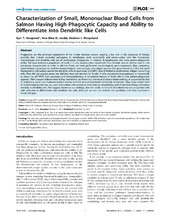| dc.description.abstract | Phagocytes are the principal component of the innate immune system, playing a key role in the clearance of foreign particles that include potential pathogens. In vertebrates, both neutrophils and mononuclear cells like monocytes, macrophages and dendritic cells are all professional phagocytes. In teleosts, B-lymphocytes also have potent phagocytic ability. We have isolated a population of small (<5 µm), mononuclear blood cells from Atlantic salmon (Salmo salar L.) not previously characterized. In order to identify them, we have performed morphological, gene expression, flow cytometry, cytochemical, ultrastructural and functional analyses. Interestingly, they highly express the gene encoding CD83, the most characteristic cell surface marker for dendritic cells in mammals, and MHC class II limited to professional antigen presenting cells. They did not express genes nor did they have cell markers for B-cells, T-cells, monocytes/macrophages or neutrophils as shown by qRT-PCR, flow cytometry and immunoblotting. A remarkable feature of these cells is their potent phagocytic capacity. Their oxygen-independent killing mechanism, as shown by intense acid phosphatase staining, is supported by lack of respiratory burst and myeloperoxidase activity and the acid phosphatase's sensitivity to tartrate. They show a high level of morphological plasticity, as, upon stimulation with mitogens, they change morphology and obtain branching protrusions similarly to dendritic cells. We suggest, based on our findings, that the small, round cells described here are progenitor cells with potential to differentiate into dendritic like cells, although we can not exclude the possibility that they represent a novel cell type. | en_US |

